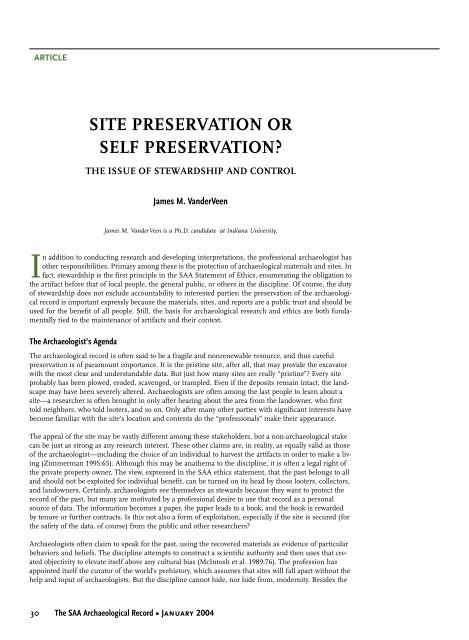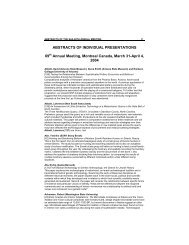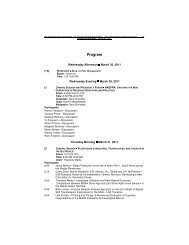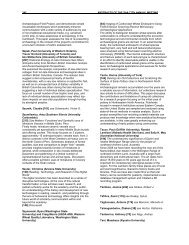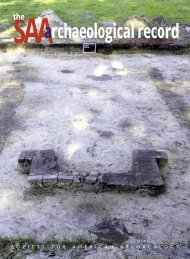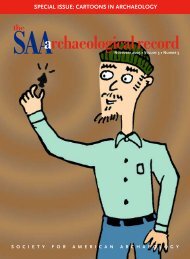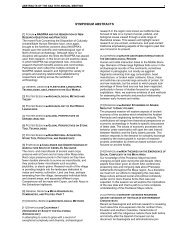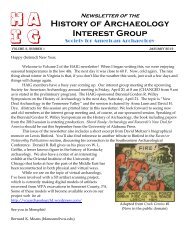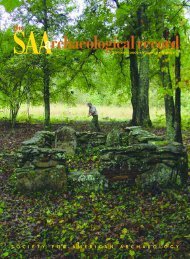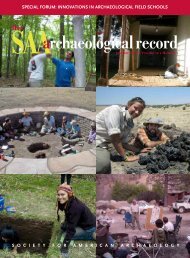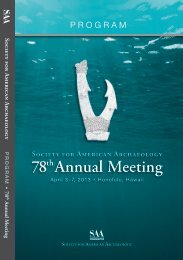Number 1, January - Society for American Archaeology
Number 1, January - Society for American Archaeology
Number 1, January - Society for American Archaeology
Create successful ePaper yourself
Turn your PDF publications into a flip-book with our unique Google optimized e-Paper software.
ARTICLE<br />
SITE PRESERVATION OR<br />
SELF PRESERVATION?<br />
THE ISSUE OF STEWARDSHIP AND CONTROL<br />
James M. VanderVeen<br />
James M. VanderVeen is a Ph.D. candidate at Indiana University.<br />
In addition to conducting research and developing interpretations, the professional archaeologist has<br />
other responsibilities. Primary among these is the protection of archaeological materials and sites. In<br />
fact, stewardship is the first principle in the SAA Statement of Ethics, enumerating the obligation to<br />
the artifact be<strong>for</strong>e that of local people, the general public, or others in the discipline. Of course, the duty<br />
of stewardship does not exclude accountability to interested parties; the preservation of the archaeological<br />
record is important expressly because the materials, sites, and reports are a public trust and should be<br />
used <strong>for</strong> the benefit of all people. Still, the basis <strong>for</strong> archaeological research and ethics are both fundamentally<br />
tied to the maintenance of artifacts and their context.<br />
The Archaeologist’s Agenda<br />
The archaeological record is often said to be a fragile and nonrenewable resource, and thus careful<br />
preservation is of paramount importance. It is the pristine site, after all, that may provide the excavator<br />
with the most clear and understandable data. But just how many sites are really “pristine”? Every site<br />
probably has been plowed, eroded, scavenged, or trampled. Even if the deposits remain intact, the landscape<br />
may have been severely altered. Archaeologists are often among the last people to learn about a<br />
site—a researcher is often brought in only after hearing about the area from the landowner, who first<br />
told neighbors, who told looters, and so on. Only after many other parties with significant interests have<br />
become familiar with the site’s location and contents do the “professionals” make their appearance.<br />
The appeal of the site may be vastly different among these stakeholders, but a non-archaeological stake<br />
can be just as strong as any research interest. These other claims are, in reality, as equally valid as those<br />
of the archaeologist—including the choice of an individual to harvest the artifacts in order to make a living<br />
(Zimmerman 1995:65). Although this may be anathema to the discipline, it is often a legal right of<br />
the private property owner. The view, expressed in the SAA ethics statement, that the past belongs to all<br />
and should not be exploited <strong>for</strong> individual benefit, can be turned on its head by those looters, collectors,<br />
and landowners. Certainly, archaeologists see themselves as stewards because they want to protect the<br />
record of the past, but many are motivated by a professional desire to use that record as a personal<br />
source of data. The in<strong>for</strong>mation becomes a paper, the paper leads to a book, and the book is rewarded<br />
by tenure or further contracts. Is this not also a <strong>for</strong>m of exploitation, especially if the site is secured (<strong>for</strong><br />
the safety of the data, of course) from the public and other researchers?<br />
Archaeologists often claim to speak <strong>for</strong> the past, using the recovered materials as evidence of particular<br />
behaviors and beliefs. The discipline attempts to construct a scientific authority and then uses that created<br />
objectivity to elevate itself above any cultural bias (McIntosh et al. 1989:76). The profession has<br />
appointed itself the curator of the world’s prehistory, which assumes that sites will fall apart without the<br />
help and input of archaeologists. But the discipline cannot hide, nor hide from, modernity. Besides the<br />
30 The SAA Archaeological Record • <strong>January</strong> 2004


